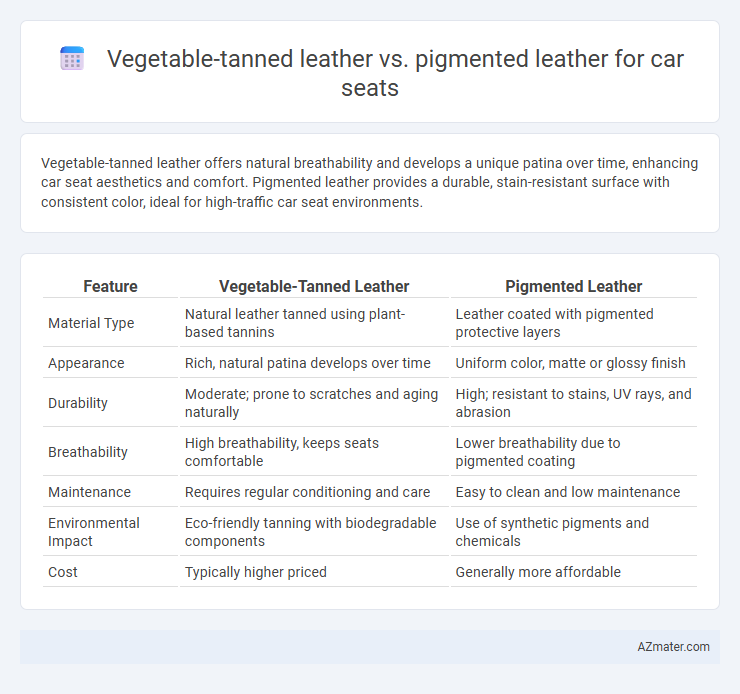Vegetable-tanned leather offers natural breathability and develops a unique patina over time, enhancing car seat aesthetics and comfort. Pigmented leather provides a durable, stain-resistant surface with consistent color, ideal for high-traffic car seat environments.
Table of Comparison
| Feature | Vegetable-Tanned Leather | Pigmented Leather |
|---|---|---|
| Material Type | Natural leather tanned using plant-based tannins | Leather coated with pigmented protective layers |
| Appearance | Rich, natural patina develops over time | Uniform color, matte or glossy finish |
| Durability | Moderate; prone to scratches and aging naturally | High; resistant to stains, UV rays, and abrasion |
| Breathability | High breathability, keeps seats comfortable | Lower breathability due to pigmented coating |
| Maintenance | Requires regular conditioning and care | Easy to clean and low maintenance |
| Environmental Impact | Eco-friendly tanning with biodegradable components | Use of synthetic pigments and chemicals |
| Cost | Typically higher priced | Generally more affordable |
Overview of Vegetable-Tanned vs Pigmented Leather
Vegetable-tanned leather for car seats offers natural durability, eco-friendliness, and a unique patina that develops with time, enhancing its aesthetic appeal. Pigmented leather features a synthetic coating that provides superior stain resistance, color uniformity, and easier maintenance, making it ideal for high-traffic vehicle interiors. Choosing between these leathers depends on the desired balance between natural aging characteristics and practical protection for automotive seating surfaces.
Key Characteristics of Vegetable-Tanned Leather
Vegetable-tanned leather for car seats is known for its natural appearance, breathability, and durability, as it is tanned using organic tannins extracted from tree bark and plant materials. This leather develops a unique patina over time, enhancing its aesthetic appeal while maintaining resistance to wear and tear. Unlike pigmented leather, which features a protective surface coating, vegetable-tanned leather offers a more supple feel and ages gracefully with minimal artificial treatment.
Main Features of Pigmented Leather
Pigmented leather for car seats features a protective polymer coating that enhances durability and resistance to stains, UV damage, and wear. This type of leather offers a uniform color and texture, making it easier to maintain and clean compared to vegetable-tanned leather. Its surface treatment ensures long-lasting appearance and protection, ideal for high-traffic automotive interiors.
Durability Comparison: Which Lasts Longer?
Vegetable-tanned leather, known for its natural fibers and minimal chemical treatment, offers a durable and breathable surface that develops a unique patina over time, enhancing its longevity in car seats. Pigmented leather, coated with a protective polymer layer, provides superior resistance to stains, UV rays, and abrasion, making it highly durable and easier to maintain under daily use. Despite vegetable-tanned leather's aesthetic appeal, pigmented leather generally lasts longer in automotive environments due to its enhanced protection against wear and environmental factors.
Comfort and Aesthetic Appeal Differences
Vegetable-tanned leather car seats offer a natural breathability and develop a unique patina over time, enhancing comfort by adapting to body temperature and providing a soft, supple feel. Pigmented leather features a durable, uniform coating that resists stains and fading, maintaining a consistent aesthetic appeal but often sacrificing breathability and flexibility. The choice between these leathers influences both tactile comfort and long-term visual character, with vegetable-tanned leather favored for luxury warmth and pigmented leather preferred for easy maintenance and vibrant color retention.
Maintenance and Care Requirements
Vegetable-tanned leather for car seats requires regular conditioning with natural oils to prevent drying and cracking, ensuring its durability and rich patina over time. Pigmented leather offers easier maintenance with a protective coating that resists stains and fading, needing only mild cleaning and occasional conditioning to preserve its appearance. Both types benefit from avoiding direct sunlight and harsh chemicals, but pigmented leather is generally more forgiving for busy car interiors.
Environmental Impact Analysis
Vegetable-tanned leather, derived from natural tannins in tree bark and plants, offers a more sustainable and biodegradable option for car seats compared to pigmented leather, which relies heavily on synthetic dyes and chemical coatings. The production of pigmented leather involves toxic chemicals and generates higher emissions, resulting in a more significant environmental footprint throughout its lifecycle. Vegetable-tanned leather's lower chemical use and enhanced biodegradability contribute to reducing pollution and waste, making it a greener choice for automotive interiors.
Cost Comparison for Car Owners
Vegetable-tanned leather typically costs more than pigmented leather due to its natural tanning process and higher durability, making it a long-term investment for car owners seeking premium quality and comfort. Pigmented leather, coated with a protective layer, offers a cost-effective alternative with lower initial expenses, ideal for budget-conscious buyers prioritizing easy maintenance. While vegetable-tanned leather may incur higher upfront costs, pigmented leather reduces potential repair and cleaning expenses over time, influencing overall ownership costs.
Best Use Cases for Each Leather Type
Vegetable-tanned leather offers superior breathability and develops a rich patina over time, making it ideal for luxury car seats where comfort and aesthetic aging are prioritized. Pigmented leather features a durable protective coating that resists stains, UV damage, and wear, making it the best choice for daily-use vehicles and environments prone to spills or heavy use. Choosing between these leathers depends on balancing desired longevity, maintenance effort, and the interior's exposure to environmental factors.
Which Leather is Best for Your Car Seats?
Vegetable-tanned leather offers a natural, breathable surface that develops a unique patina over time, enhancing comfort and aesthetics in car seats. Pigmented leather, coated with a protective layer, provides superior durability and resistance to stains, making it ideal for high-traffic vehicles. Choosing between them depends on whether you prioritize natural feel and aging beauty or long-lasting protection and ease of maintenance.

Infographic: Vegetable-tanned leather vs Pigmented leather for Car seat
 azmater.com
azmater.com